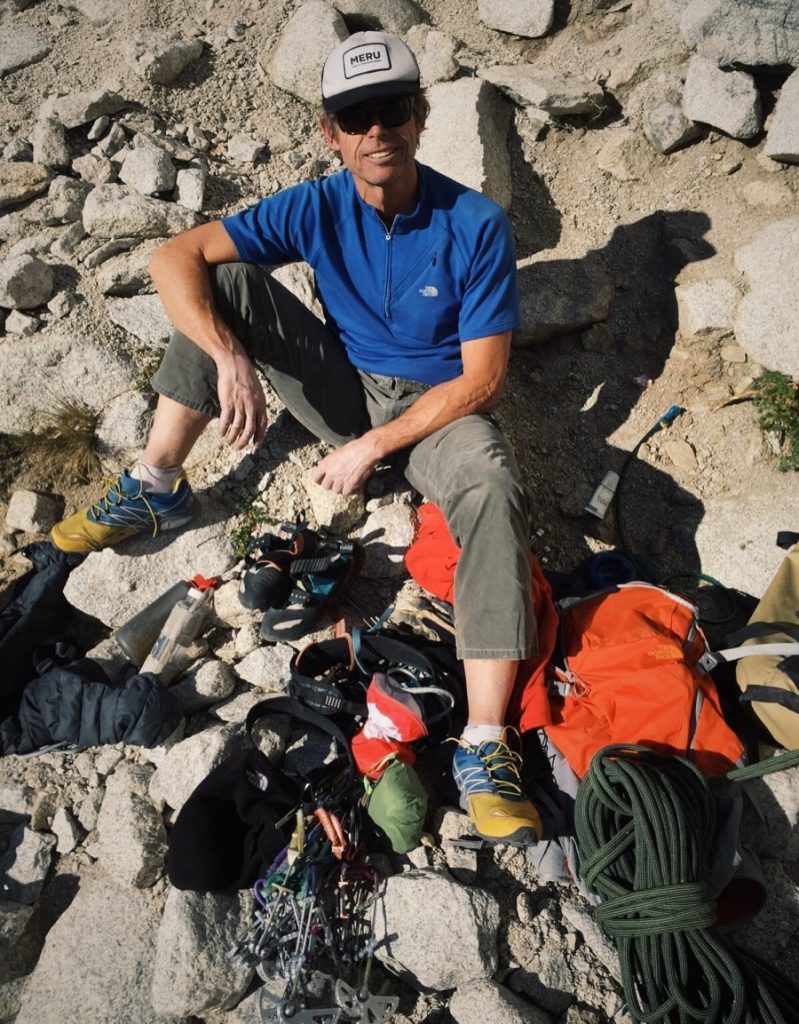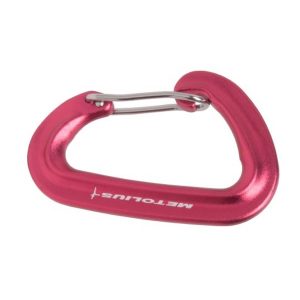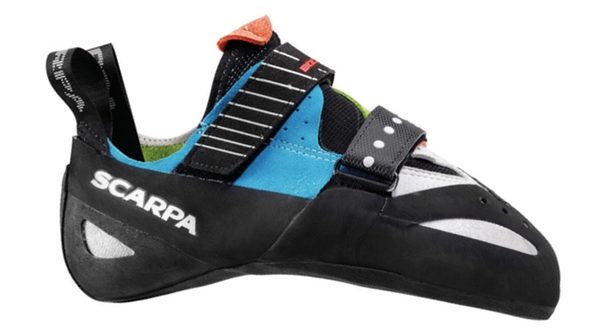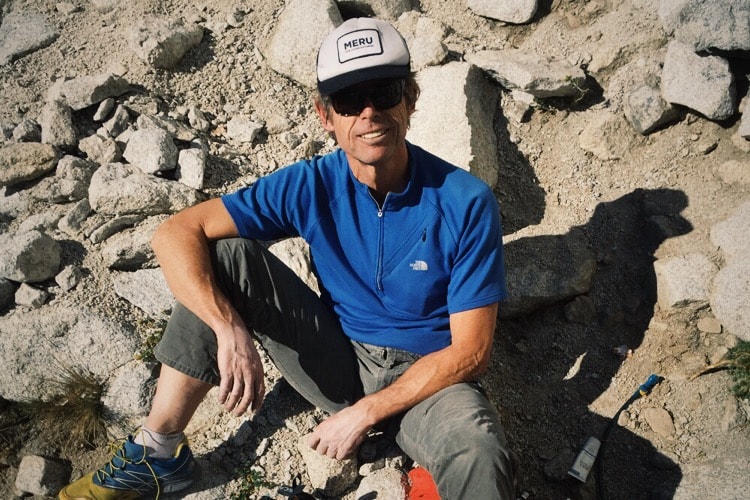What’s in Your Pack is a series where we speak with some of climbing’s leading athletes to learn about the gear that fuels their success. I recently had the opportunity to speak with Peter Croft, likely the most accomplished climber of the Sierra. Royal Robbins, a pioneer of North American climbing, even wrote:
 “Peter has been my hero for many years, ever since he came blazing out of nowhere with his stunning free solo ascent of Astroman on Washington Column in Yosemite. Tom Frost and I had made the second ascent of this route, mostly with direct aid in the early sixties. That one could climb this route without resorting to direct aid was impressive. To do it without a rope was astonishing. But such was Peter’s level of mastery. That it was mastery, and not mere daring was proven by a string of free solos of similar stature, executed to perfection.”
“Peter has been my hero for many years, ever since he came blazing out of nowhere with his stunning free solo ascent of Astroman on Washington Column in Yosemite. Tom Frost and I had made the second ascent of this route, mostly with direct aid in the early sixties. That one could climb this route without resorting to direct aid was impressive. To do it without a rope was astonishing. But such was Peter’s level of mastery. That it was mastery, and not mere daring was proven by a string of free solos of similar stature, executed to perfection.”
At 58 years old, Peter continues to establish 5.13 lines in the Eastern Sierra and upon chatting, he had just returned from putting up another first ascent on The Incredible Hulk.
Let’s start with your pack. What are you carrying?
I normally carry the North Face Cinder 55. I have 4 or 5 of them and all are 55 liters, which I think is the best size. Because of the packing and unpacking all day at the crags, cragging packs should be roomy enough to just drop in—no cramming!
I worked with the designers on this and I’m especially psyched on how it turned out. It stands up and stays open on its own, which means you don’t have to wrestle stuff in. It’s also made of especially burly material so even marmots can’t chew into it.
Could you talk about the cams you’re climbing with?
Metolius [Ultralight Master Cams]. The reason I really like Metolius cams in the first place is how light they are. Some people argue that [Black Diamond] Camalots have a greater range … and it’s true, but they’re also a lot heavier. Metolius cams have always been lighter, but the new Ultralights are just a whole level beyond that.

I actually just got out of the mountains late last night using the new Master Cams with the [FS] Mini Carabiners. A lot of people will check the weight of carabiners by picking up one carabiner and weighing it against another. That’s not really the way to do it. When you’re talking about a whole rack of lightweight cams vs regular cams, and then you add in lightweight carabiners, it’s pretty amazing.
Related: Comparing Ultralight Cams: Black Diamond Camalot UL vs. Metolius UL Master Cam Review and Lowest Prices
I heard that you love the new Mini Carabiners …
 Oh yeah. The first time I went into the backcountry with them—it was maybe 12 or 15 miles—I stopped twice to make sure I hadn’t forgotten stuff. I was used to going into the backcountry and thinking that if I would be doing technical climbing, my pack had to be big and heavy.
Oh yeah. The first time I went into the backcountry with them—it was maybe 12 or 15 miles—I stopped twice to make sure I hadn’t forgotten stuff. I was used to going into the backcountry and thinking that if I would be doing technical climbing, my pack had to be big and heavy.
I thought I have to be forgetting something. I stopped and checked it once, checked everything, and started hiking. Then a while later, I thought again, I have to be forgetting something. My pack is too small.
I wasn’t forgetting anything. It really does make that much of a difference having a whole rack of lightweight gear verse a normal rack.
Tell us about your racking strategy.
It depends a bit on the weather but basically, everything goes on my harness.
I say it depends on the weather because I’ll often have shoulder-length slings over my shoulder. But, if it’s really cold and I have a hat on, I’m constantly knocking my hat off with them over my shoulder. In that case, I’ll make alpine draws.
Related: This Week’s Best Climbing Gear Deals: Cams, Shoes, Ropes, and More
If I have a double rack, it’s even on both sides, starting with the biggest gear in the back, going toward the smallest up front. Behind the cams, I have quickdraws because I don’t need to look at them. You can grab them by feel.
No matter what, I like to have the belay devices way back behind.
Then up front, I’ll have nuts and if I know there will be a lot of nut placements, I’ll carry brass nuts as well.
How do you decide between carrying quickdraws and alpine draws? Are you carrying both? Mostly one over the other?
I usually take a bit of both. You know, this new route I put up yesterday, it’s pretty hard. And when you’re going for the clip you don’t want the carabiner slipping around.
But in general, it kind of depends. If you want to go ultralight, on some things you don’t need a full-length sling. A full-length sling tripled up is heavier. And carabiners flip around so if it’s a hard clip, you might be fumbling there a bit.
What about your anchors? Are you using slings or are you just making them out of the rope?
I’m generally building them just with the rope. I went through a phase where I was doing the cordelette thing … it was kind of what everyone was doing.
Then someone showed me the double-figure-8 knot. Once I found that, I stopped using cordelette altogether.
It’s just an extra piece of stuff that takes a bunch of extra time. In a classic situation, where you just have two bolts for an anchor, you have to use twice as much gear with cordelette and it takes about three times as much time.
With cams, I’ll just get them in the right place and I’ll tie figure eight loops and I’m done. It’s certainly quicker.
And another thing, related to using the rope, is that people will say, “Oh, that’s not perfectly equalized.” Engineers have analyzed this and say that perfect equalization virtually never happens. Even when you equalize, because of the direction of force, it goes a bit more on one piece verse the other. And it’s really not that important in most cases.
What I’m talking about here is longer routes where time is an issue. And if you have to bivy without bivy gear because you’ve taken so long to set up anchors, then that’s oftentimes a way bigger risk than any type of equalization concerns.
Do you suggest this anchor-building method for all levels of trad climbers?
Yeah. Everything else being equal, the simplest thing is the safest thing. In other words, the more you can simplify things, the less that can go wrong.
If you look at Accidents in North American Mountaineering, it’s not because people didn’t equalize things perfectly using cordelettes and stuff, it’s because they screwed up a step, didn’t understand what was going on, or forgot to do this or that.
The simpler you can do things, the safer it is.
That’s great. Now, onto other aspects of your gear, what type of shoes are you using?
I’ve been using the Scarpa Boostics. They’re kind of like a sport climbing shoe, I guess, but a friend turned me onto them about a year ago.
Then I ran into a Scarpa fan, Josh Wharton, and he’s a super good all-arounder. He free climbs El Cap, he goes hard on sport climbs, and does big alpine routes. I was climbing with him a couple months ago and he saw that I was wearing Boostics.

Josh goes, “Ah, those are my favorite shoes.”
I ask him, “Your favorite for what? Bouldering? Sport climbing?”
He says, “No no, I have about four different sizes and if I’m going sport climbing, I wear the tighter ones. If I’m doing longer routes, I go a size up from that, and if I’m rock climbing up in the mountains I wear a size up from that.”
They’re his go-to shoe, and for me, they work fantastic.
Are you sponsored by Scarpa, or is it that out of all the possible shoes on the market, you’ve chosen the Boostics?
I could climb in any shoes I want. I’m not sponsored by Scarpa just now but yes, the Boostics are the best shoes I’ve found.
Tell us about your harness.
I have the [Metolius] Safe Tech Comp and I also use the Men’s Deluxe, which I really like if I’m going to be on a lot of hanging belays.
The double belay/rappel loop—I didn’t really think that was such a big deal because I know a single one is super safe. But I actually end up using them a lot; it’s much more valuable than I thought. Like yesterday, after doing this wall we had to do 12 rappels to get back down and I liked having a tether off of each loop.
Learn more: Metolius Safe Tech Harnesses for sale at Backcountry.com
Also, with the Safe Tech harnesses, everything is full-strength, including the gear loops. At times, I use that. Say I build an anchor in one place but there’s a bit of a ledge off to the side. Then, I might clip something into my gear loop that pulls me over so I’m more comfortable.
People will say, “Why would you need a gear loop as strong as that?” And, for those reasons, it’s really good.
That makes perfect sense. I’ve been wondering about the usefulness of full-strength gear loops …
Well this one time, I was using a non-Metolius harness up on El Cap and I had a really light rack. I was climbing The Nose in a day and I had half the gear on one side and half on the other.
Two-thirds of the way up, at the Great Roof, one of the gear loops—I wasn’t even in a chimney or anything—blew and half my rack went to the bottom! And, the rest of the climb I had a very, very small rack …
Having everything really strong, the gear loops included, is one of the things that Metolius does so well. They have a lot of history with trad climbing, whereas there are a lot of European harnesses that are great and comfortable and safe, but they just don’t take that into account as well.
What about belay devices? Are you using both a GriGri and ATC?
Yeah, exactly. Obviously, you want an ATC and in my case, I’m carrying the Metolius BRD (Belay/Rappel Device).
Related: What Ashima Shiraishi’s 45-Foot Fall Can Teach Us About GriGris
Having a GriGri, the hands-off feature—even though they say you’re not supposed to take your hands off of it—is really nice. Over the course of a long day, the rope handling really gets to you and that’s one of the benefits of a GriGri.
So, are you lead belaying with the GriGri and then belaying in guide mode at the top? Or belaying with the GriGri from the top, as well?
I’m using the GriGri from the top. I’m basically just using the other belay device for rappelling.
What kind of rope are you packing?
I’ve been using the Monster Ropes. I always go for the thinnest single rope I can find. Pretty much always, I’m going with the 8.9mm 70m. Nowadays, I use 70m as my minimum size; I don’t like having anything shorter than that.
What’s the lifespan on a rope that skinny?
I find that they last really well. I have a bunch of ropes and I kind of alternate between them. I would think, if I just had one, it might last a year.
I don’t date the ropes and say, “Ok, after X months I’ll throw it out.”
But, what I’ll do every once in a while—particularly after a big climb—is take five minutes to check the rope. And what that means is just lay it out and feel the whole rope, checking for any soft spots. Also, you’re obviously looking for any core showing through.
As long as it’s nice and evenly firm throughout—with no core shots—I’ll keep using it.
Are there any oddities you’re packing into the mountains?
Not so much, but since I’ve been up in the mountains a lot this summer, there are a few things that I think are really good to have …
If you’re trying to stay warm in the mountains, one of the problems with a big puffy jacket is that it’s difficult to climb hard. One thing that I’ve found that makes a huge difference—and obviously you can wear a wool hat—but also a neck gaiter. Once I started using one—along with a windbreaker—I found that I can stay really warm without looking like the Michelin Man.
It’s good to have one of those windbreakers that fits into its own pocket and then you can clip it to the back of your harness. The nice thing about a neck gaiter is that you can just clip it into a carabiner since it’s a tube.
For hard climbing, that’s the thing: to be able to stay warm without the jacket getting in the way.
I also like to have a pair of Grip Gloves. Taking care of your hands on big days is huge but bulky gloves get in the way. The Grip Gloves are really light and form-fitting, so they work great for belaying and rappelling but are also good for scrappy down-climbing descents.
How much water do you pack and are you putting it in a bladder?
I used to hardly drink any water on long routes—I just don’t get that thirsty and I’m not a super sweaty guy. But I’ve read up on it and basically, you should be drinking more water. Yesterday, I was up at higher altitude, and it’s even more important up there.
What I try to do about 24-48hr beforehand is make sure that I’m well-hydrated. Then going into the climb, even if I get a little thirsty, my body has been hydrated.
Yesterday, we were climbing for about 12 hours or something like that, and I had about a quart with me. For that, I just used a water bottle clipped to the back of my harness.
In The Incredible Hulk video, you’re having morning coffee and say, “I love it when I start to vibrate.” How much coffee are you drinking and how do you make it in the mountains?
Just drip coffee—a cone with a filter. It’s how I make it at home, too. I’ve tried expensive machines but I think this is the best way. And I usually drink a few cups of really strong coffee.
Are you taking the time to make coffee, even with an extremely early start?
Yeah, I’m an early riser anyways. I’ve been with people and I say, “Ok, we have to get up at 4.”
They say, “Ok, that sounds great, and uh, I should be good to go in about fifteen minutes, say 4:15.”
I’m like no, that’s not how it works at all. It takes at least an hour when you’re up in the mountains from when you get up to when you’re actually hiking toward the peak or the wall.
It’s the whole waking-up process: having coffee, making breakfast, making sure you’re not forgetting anything. During alpine starts in the dark, it’s easy to leave things behind. I’d rather get up extra early and just have a relaxed getting-ready session—which means having plenty of coffee and starting to vibrate—and doing it right rather than jumping out of bed and rushing out the door.
Could you compare the gear you started climbing with to the gear that you’re using now?
When I started, I wanted to save up to buy the biggest strongest stuff. So, the first rope I used was 11.5mm. I don’t even think you can get those anymore! And the rope I’m using now is under 9mm.
The carabiners I use now probably weigh about a quarter as much and they’re just a fraction of the size.
When I started climbing, there weren’t any cams. But the first cams I did get had that heavy shaft. The cams today work so much better, and probably weigh a third as much.
The first harness I had was not very comfortable. In fact, after a while, I switched from a harness with leg loops to just using a swami belt without leg loops because it was so uncomfortable.
When was this?
In the late 70s—I’ve been climbing a long time! The first harness was called a Whillans harness. It wasn’t very comfortable. But the thing is, back then, this was cutting edge. People look back and wonder, How were you climbing like that? How did you climb without cams or sticky shoes?
In the future, we’re going to have better gear than we have right now and people will wonder how climbers were using that stuff back in 2010 or 2015.
And your first climbing shoes?
The first climbing shoes I had—everyone agreed—were terribly uncomfortable. Not only are the shoes now using stickier rubber, but as long as you find the right shoes and don’t get sucked into what the latest model is, you can find excellent climbing shoes that perform incredibly well and at the same time are very comfortable.
Which would you say had a greater impact on your climbing: the invention of cams or sticky rubber?
I think cams; the fact that you could fire in a multi-directional belay so quickly. With sticky rubber, some people think it was revolutionary and yeah, you could stick to things a bit better. Nowadays, trying really hard to get a certain type of rubber, I just don’t think it’s that big of a deal.
When sticky rubber first came, I noticed it. But the biggest thing, bigger than the stickiness, was that the Boreal shoes—the first ones with sticky rubber—were just so much more comfortable. They were just higher-performing and better made.
Excellent. That wraps it up!
We’d like to extend a warm thank you to Peter for offering his time. It’s not every day that the climbing community can learn from a true master. We’re delighted to share his words and wish him all the best as he continues to push our sport forward.
Want more climbing content? Get our awesome climbing newsletter, delivered weekly.
Explore more
- What’s In Your Pack: Ethan Pringle
- Our 30+ most popular articles ever
- How to Build a Trad Rack
- Gear You Ought to Know: Tricams
- Gear You Ought to Know: Offset Nuts
- How to Build a Climbing Anchor with 3 Pieces and 2 Slings
- 4 Steps to Transition to Alpinism
- 10 Tips for the Aspiring Crack Climber
- Free eBooks on rock climbing technique, knots, training games, and more
- Best Deals on Climbing Gear This Week








